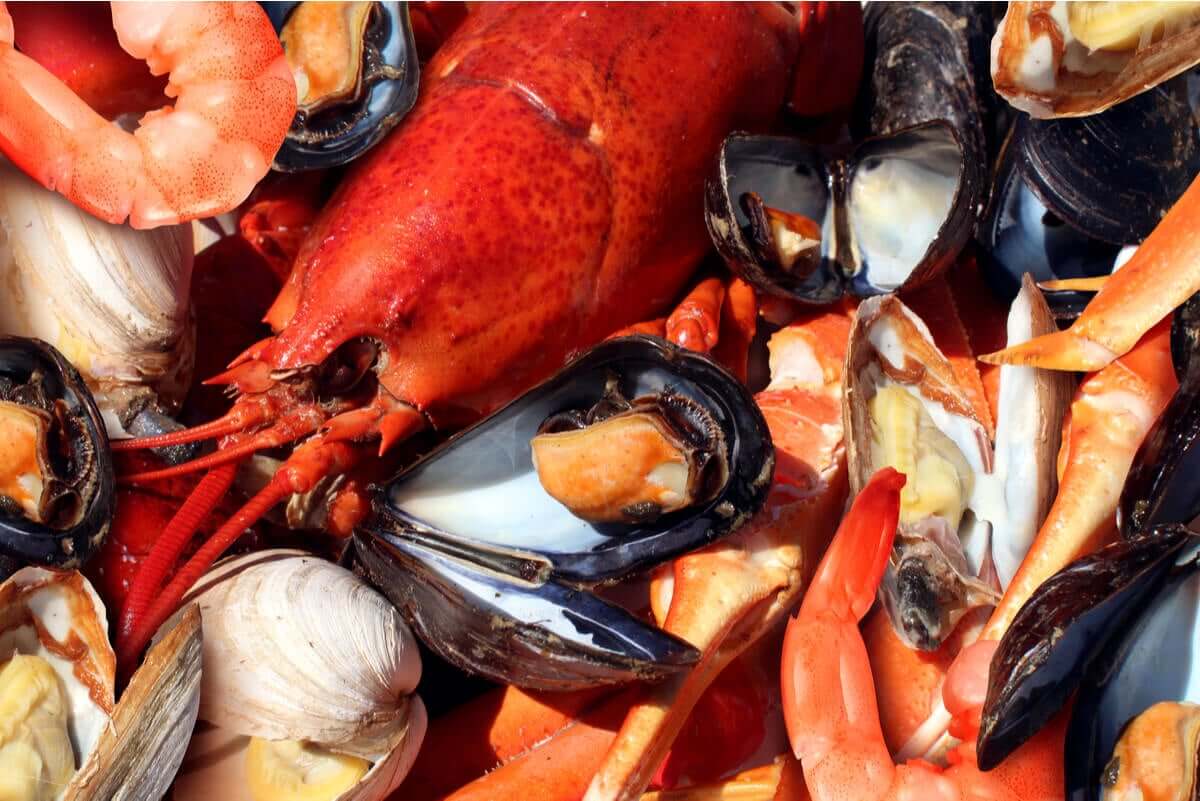Shellfish Allergies: Symptoms and Treatments


Written and verified by the nutritionist Saúl Sánchez Arias
Shellfish allergies are one of the most common types of allergies. Mollusks and crustaceans can easily cause the immune system to jump into overdrive to fight off the allergen, resulting in mild to severe reactions. Severe allergic reactions can be extremely dangerous, therefore it’s important to understand the symptoms to avoid major complications.
When a substance enters the body, the immune system decides if it needs to fight it off or let it through. In the case of shellfish allergies, the immune system identifies the protein as harmful and reacts to protect the body. Sometimes these reactions can evolve in such a serious way that they’re potentially life-threatening.
What are shellfish allergies?
As described by a study in the Current Opinion in Allergy and Clinical Immunology, shellfish allergies are caused by specific proteins found in certain seafood. The more common allergy-producing seafood are crustaceans and mollusks.
Once the body detects an allergen, it triggers a defense reaction that can result in mild symptoms such as hives or light swelling, or more serious symptoms like anaphylaxis.
A family history of shellfish allergies is one of the biggest risk factors for a person potentially developing the allergy. Additionally, this type of allergy is more common in adults than in children, though it can appear at any stage in the lifespan. Furthermore, shellfish sensitivity is more common in women than in men.

Learn more: Everything You Need to Know About Lactose Intolerance
What are the symptoms?
As we’ve mentioned before, allergy symptoms can be mild or severe. Generally speaking, the first signs of an allergic reaction appear about an hour after consuming shellfish. Typical signs are swelling and itching of the lips and/or tongue.
In more severe cases, you might have difficulty breathing or present intestinal issues, like diarrhea, stomach pain, and vomiting. This type of reaction usually calls for medication and taking a probiotic, which has been shown to control persistent diarrhea.
Other symptoms like dizziness, lightheadedness, and fainting or loss of consciousness can also occur. If any of these signs appear, seek medical attention to monitor progress and take medication, if necessary.
Anaphylaxis
Shellfish allergies can lead to anaphylaxis, a life-threatening side effect that requires immediate medical attention. In fact, adrenaline injections in the form of epi-pens are the first and fundamental line of treatment, as confirmed by a study published in the Jornal de Pediatria.
Symptoms of anaphylaxis include difficulty breathing from swelling of the throat, a drop in blood pressure, confusion, dizziness, fainting, or loss of consciousness.
What are the possible complications?
There are certain pre-existing conditions that can dramatically worsen a person’s susceptibility to anaphylactic shock. For example, if a person has asthma, a family history of anaphylaxis caused by food allergies, or a personal history of allergic reactions to shellfish, there’s a high likelihood that hypersensitivity can become complicated.
Because of this, it’s extremely important to carefully review the labels of all the foods you buy. This way, you can ensure that there’s no cross-contamination or traces of foods that might trigger an allergic reaction.
If you have severe shellfish allergies, you might even need to stay away from anywhere where seafood and shellfish are processed and cooked. The odors or fumes the shellfish let off can trigger adverse reactions.
You might like: The Relationship Between Asthma and Rhinitis
How to treat shellfish allergies
Currently, there’s no fool-proof cure for shellfish allergies. This food allergy is a process that, once it appears, will likely last the rest of your life.
Accordingly, the only thing you can really do is try to avoid ingesting shellfish and accidentally breathing in their fumes. Of course, this only applies if you already have a confirmed shellfish allergy.
If you go to a restaurant, check to confirm the menu has an allergen chart or label. Using this, you’ll be able to see which dishes contain shellfish and which don’t.
Carefully read food labels to confirm the food wasn’t packed or processed in a factory that also processes seafood. It’s highly likely that if it was, the food will contain some traces of shellfish, which can be dangerous.
Shellfish allergies in children
As we’ve already mentioned, it’s more common to develop a shellfish allergy in adulthood than in childhood, though the latter is certainly possible. If you notice any negative reaction in your child after consuming shellfish, we recommend carrying an epi-pen for emergencies. This could help save the child’s life by preventing anaphylactic shock.
Parents and guardians should be very careful in making sure the child doesn’t eat shellfish or food contaminated by the allergen. However, if the child shows symptoms of hypersensitivity like swelling, itching, or inflammation in the mouth for the first time, it’s best to take a trip to the emergency room.
How to prevent allergic reactions
If you or your child has a shellfish allergy, follow these useful tips to help prevent potential exposure.
Read food labels
Make sure all the food products you buy from the grocery store are free of allergens by reading food labels. This way, you can avoid problems down the line.
Be careful when eating out
These days, restaurant menus normally have a section that highlights potential allergens in their dishes. Still, it’s always a good idea to let the server know about your allergy so they can take the proper precautions to avoid cross-contamination of foods.

Cross-contamination
People with food allergies can have a reaction by eating foods prepared in a contaminated dish or with the same utensils. In other words, you don’t have to ingest shellfish to have a reaction or anaphylaxis. It’s enough to eat food that touched the same surface as the shellfish, which is why hygiene is extremely important.
Shellfish allergies are a food-related issue
As you’ve learned, shellfish allergies can be life-threatening if a person doesn’t take precautions. Because of this, it’s always important to read food labels and seek immediate medical attention if you think you’re having an allergic reaction.
If your fears are confirmed, remember to always carry an epi-pen in case you need to use it one day. This is also important for parents and guardians of children with shellfish allergies, who need to take special precautions in making sure their child stays away from possible allergens.
All cited sources were thoroughly reviewed by our team to ensure their quality, reliability, currency, and validity. The bibliography of this article was considered reliable and of academic or scientific accuracy.
- Szajewska H., Canani RB., Guarino A., Hosjak I., et al., Probiotics for the prevention of antibiotic associated diarrhea in children. J Pediatr Gastroenterol Nutr, 2016. 62 (3): 495-506.
- Sarinho E., Moura MG., Severe forms of food allergy. J Pediatr, 2017. 1: 53-59.
- Wong L., Tham EH., Lee BW., An update on shellfish allergy. Curr Opin Allergy Clin Immunol, 2019. 19 (3): 236-242.
- Velazco-Benítez, C. “Epidemiología de la alergia alimentaria en la edad pediátrica.” Rev Gastrohnup 14.2 (2012): 62-5.
- García Falcón, Manuel Enrique. “Papel de los probióticos en el tratamiento de alergias e intolerancias alimentarias.”
- Borrego, J. Torres, JF Martínez Cuevas, and J. Tejero García. “Reactividad cruzada entre pescados y mariscos.” Allergologia et immunopathologia 31.3 (2003): 146-151.
- Fernández Morales, Isidora, and María Ignacia Von Jentschykmakuc. “Abordaje nutricional en alergias alimentarias más prevalentes.” (2016).
- Binaghi, María Julieta, et al. “Declaración de alérgenos y detección de trazas de leche, soja y huevo en alimentos de consumo frecuente por niños.” Actual. nutr (2017): 72-83.
- Plaza-Martin, Ana María. “Alergia alimentaria en la edad pediátrica, conceptos actuales.” Anales de pediatría. Vol. 85. No. 1. Elsevier Doyma, 2016.
- Blasco, Jaime Lozano, Sergio José Quevedo Teruel, and Mónica Piquer Gibert. “Alergia a frutos secos. Alergia a legumbres y frutas. Alergia a pescados y mariscos.”
This text is provided for informational purposes only and does not replace consultation with a professional. If in doubt, consult your specialist.








